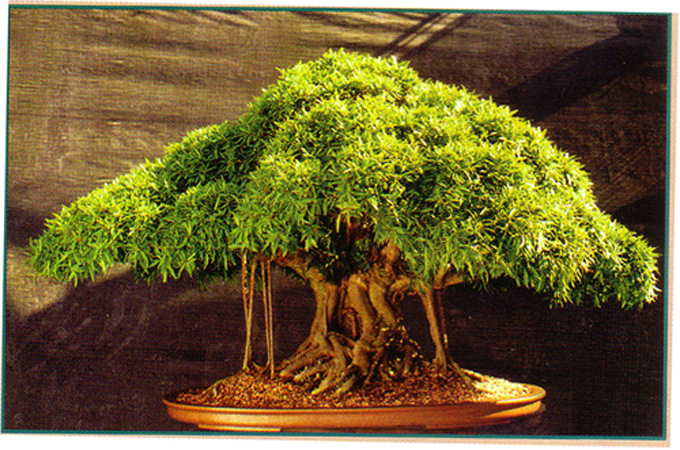 Your bonsai may never look like this, but they can be this healthy. This magnificently robust Willow leaf ficus (Ficus nerifolia) is by Jim Smith of Dura-Stone in Vero Beach Florida. The photo is from Bonsai Today, issue 61 and was taken by Jim.
Your bonsai may never look like this, but they can be this healthy. This magnificently robust Willow leaf ficus (Ficus nerifolia) is by Jim Smith of Dura-Stone in Vero Beach Florida. The photo is from Bonsai Today, issue 61 and was taken by Jim.
While we’re on basic bonsai health topics, we might as well discuss fertilizing. And, because I’m traveling again we’ll dig into our archives. All the way back to May 2009 (with some fairly extensive adding and editing this time).
Your bonsai depend on you
Bonsai do not survive on water, light, and love alone. Because most bonsai soil has very low nutritive value (if any), your bonsai depend on you for feeding.
Feed generously
Feed generously if you want your bonsai to thrive. The best way to do this is frequent moderate doses during the growing season. This is especially true if you use liquid fertilizer. With pellets and cakes, how often you apply them depends on how they break down (more on this below).
The perils of not feeding enough
Most people underfeed their bonsai. This may be because they want them to stay small, so they don’t feed much, if at all. What you end up with if you don’t feed enough, may or may not be small, but it will be unhealthy.
Healthy trees
Healthy trees take better to the deprivations of small container growing and other insults like severe top pruning, bending, carving and rootpruning. So make sure your bonsai get the nutrition they need, especially during the peak growing season from spring through mid summer.
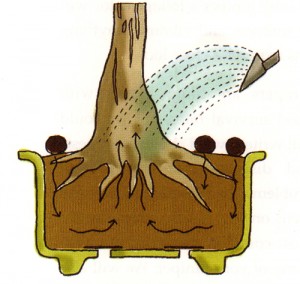
When you use pellets or other solid fertilizers, each time you water, nutrients are washed down into the soil. Illustrations are from our Juniper book.
Organic fertilizers
Many bonsai enthusiasts and professionals swear by slow release organic pellets and cakes. Japanese bonsai growers have been using them for a very long time with excellent results. Some people supplement with liquid fertilizer. There are benefits to using more than one type of fertilizer, as each type has its strengths. There’s a lot more that can be said about organic vs non-organic and the use of liquid fertilizers, but we’ll save that for another time.
Most pellets and cakes and other organic fertilizers (for example liquid fish) are mild (have fairly low N-P-Ks) and tend to have a broad spectrum of macro and micro nutrients.
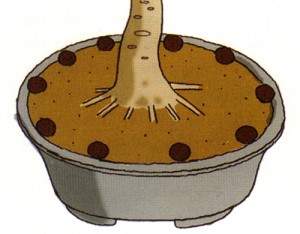 When trees are in the pot for a long time, the roots spread to the edge of the pot, so you want to place the fertilizer near the edge; the fine feeder roots that absorb water and nutrients are mostly at the outer reaches of the root system. These fertilizer balls (or cakes) are large, so not too many are needed. If use pellets, then you need more. In my experience, most people sprinkle the pellets over the entire soil surface, not just the edges. Still to encourage roots to grow out, the edges are important.
When trees are in the pot for a long time, the roots spread to the edge of the pot, so you want to place the fertilizer near the edge; the fine feeder roots that absorb water and nutrients are mostly at the outer reaches of the root system. These fertilizer balls (or cakes) are large, so not too many are needed. If use pellets, then you need more. In my experience, most people sprinkle the pellets over the entire soil surface, not just the edges. Still to encourage roots to grow out, the edges are important.
Pellets and cakes
Perhaps the best way to fertilize is with pellets, cakes or other solid forms that break down over a period of several weeks. This provides a slow steady supply of nutrients as the cakes or pellets break down. Having said this, plenty of people get good results with liquid fertilizers. Others combine solid fertilizers and liquids.
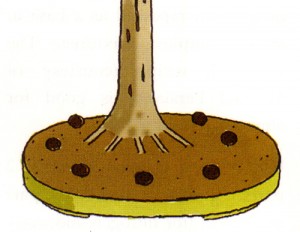 After transplanting it’s good to place the cakes (or pellets) halfway between the trunk and edge of the pot as the freshly pruned roots will not reach the edge for a while.
After transplanting it’s good to place the cakes (or pellets) halfway between the trunk and edge of the pot as the freshly pruned roots will not reach the edge for a while.
Add new pellets regularly
If you are using pellets which break down faster than the larger cakes, you can add a few pellets every week or so during the growing season. This will assure that some are at their nutrient-releasing peak at all times (this is how I fertilize with Green Dream pellets, even though Colin Lewis – Mr Green Dream – says that the pellets break down in a way that provides a steady stream of nutrients if you only apply them a few times during the growing season).
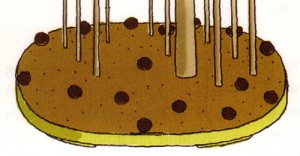 On forest style plantings, spread the cakes or pellets around so that each trunk gets its share. Be sure to put some on the inside of the forest.
On forest style plantings, spread the cakes or pellets around so that each trunk gets its share. Be sure to put some on the inside of the forest.
There is so much more that can be said about fertilizing and fertilizers, so we’ll just consider this a good start. Meanwhile you can find more information online or in bonsai books. Though you need to stay alert. Misinformation is easily as common as good information.
Sorry to bother you again but I’m a very interested beginner. You mention fertilizing during the growing season. How about in the winter and now towards the end of winter?
Hi Chuck,
Off season fertizling depends on where you live, the type tree and other factors. Too mcuh to go into here.
We’ll more on fertilizing soon.
WAYNE:
I asked this before but my computer crashed and I didn’t get the answer. My ficus has been doing well until lately some leaves are turning yellow and falling off. It doesn’t seem to be growing. What am I doing wrong? Please e-mail your answer.